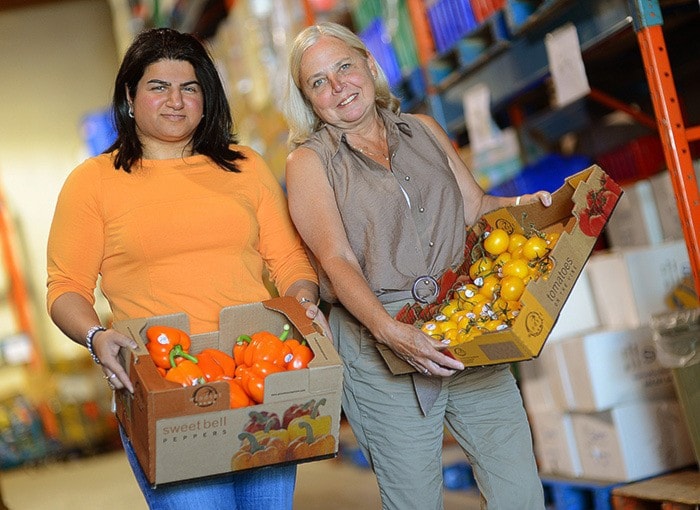On a Wednesday in April, clients of the Surrey Food Bank’s (SFB) Tiny Bundles program arrived for their bi-weekly hampers, and were stunned to see nobody outside.
The women, some pregnant, others toting their babies, saw none of the usual volunteers with food bins under the tarp outside the North Surrey building.
They wondered if the food bank was closed.
It turned out that they were some of the earliest people to see a major change in the way the food bank interacts with the 14,000 people who depend on it each month.
Starting with the Seniors’ Depot last year, “we piloted the concept of setting up tables in the warehouse so the clients could come in and ‘shop’ for their food,” explains SFB Executive Director Marilyn Herrmann.
The indoor program, with one-on-one service by volunteers, was so successful, she says, that it was expanded to Tiny Bundles, the SFB’s program for pregnant and nursing mothers.
Bringing the seniors and moms inside, she adds, makes the experience more interactive, and gives more flexibility in choosing the foods that are right for them, compared with the previous way of pre-bagged hampers.
Now, with summer underway, the food bank is taking stock and planning for the next phase: Indoor service for all clients, starting this fall.
“(There will be) no more of our volunteers and clients standing outside in the rain or cold,” Herrmann says.
Because of an ongoing lack of space, the warehouse is currently being revamped. Some of the racking is being removed, and food is being stored – at extra expense – at off-site locations.
The indoor service area will take up about half of the SFB building’s space. The area currently used for sorting and packing will move to the north side of the building.
Herrmann says the new interactive approach allows the client to connect better with the community.
Recently, Surrey firefighters made presentations about smoke alarms, Surrey Libraries brought books, and Fraser Health provided a “slipper swap” program for seniors. The school district has also expressed interest in sending staff to talk to mothers about early literacy.
During the summer, SFB staff and volunteers are going to community events to remind people about the food bank, and to check expiry dates on non-perishable donations.
“We want people to think healthy,” says Herrmann.
Cash, of course, is “wonderful”, especially with the high cost of such things as baby food.
Director of External Relations Feezah Jaffer says programs for families with young children take planning and money.
“We won’t start something unless we know we can sustain it, and we won’t start it and (then) take it away. But we need that support from the community (to do it).”
The food bank’s records show that among its Tiny Bundles clients, 89 new babies will be born this year.
Jaffer says the food bank might have to provide for each new child for the next five years, and that takes a commitment from donors – if eggs are promised, for example, eggs must be delivered.
That level of sophistication allows the SFB to tell donors how much it will cost.
Last year’s Christmas stocks are also being depleted, making more purchases necessary.
“Summer is a good time for staff and volunteers,” says Herrmann. “We’re not any busier or any less busy. It’s kind of a time we start planning for the next year… What can we do for our clients? I guess if the weather’s better, people are feeling more optimistic and revved up.”
They’ve been closely watching the seniors’ program, where client numbers are growing, the Tiny Bundles program, and the new Toddler Totes – a pre-K program for families with kids aged two to five.
As planning continues to evolve, some summer programs that proved less successful in staff/volunteer efforts versus results, such as Christmas in July and the community gardens, have been scaled back or set aside completely.
Others, such as the coordination of volunteers from corporate backers such as Envision, BMO, VanCity and Van Houtte Coffee have proceeded, and the food drives from organizations such as Loblaws, Shaw Cable, Latter Day Saints and Delview Secondary School are welcome, even at the risk of donor fatigue.
Herrmann says the food bank’s client numbers have been steady for the last few years – roughly 200-300 families each day, though some programs, such as the Seniors’ Depot, have grown.
Staff know the clients and the trends, and continue to battle the stereotype that most clients are homeless, drug abusers or lazy. In fact the majority are regular people who need help.
“These are our neighbours. These are people like you and I.”
Herrmann adds that two-thirds of clients only come once or twice, while only one-third come every time they’re eligible.
“They’re coming because they have to come” – spurred by low wages, high rents, ill health and age; people who can’t necessarily pull up their boot straps and get a job.
“That myth and fallacy that once people start using a food bank they keep coming is not true. We know that because our client visits are all tracked. So it’s not what we think, it’s what we know.”
The Surrey Food Bank always needs more volunteers (they contribute about $500,000 in mimimum-wage time per year) and donations of non-expired food and money.
For more information, visit www.surreyfoodbank.org
